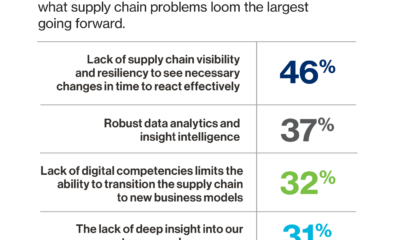Politics
Natural Gas and its Supply Chain
Published
1 year agoon
By
Drew Simpson
Natural gas is a commonly used energy source around the world. Thousands of people are employed in its supply chain, helping with drilling and extracting natural gas, treating it, and transporting it to commercial and industrial consumers.
In this article, we’ll discuss what natural gas is, explore its supply chain in greater detail, and cover some current events and recent discussions related to it. We’ll also offer tips for people interested in investing in this sector.
Key takeaways:
- Natural gas is produced over millions of years by the slow breakdown of organic matter as its pressed and heated under sand and sediment.
- Natural gas is primarily composed of methane, though it often needs to be processed when it’s first drilled from underground due to the presence of non-hydrocarbon compounds like sulfur and helium.
- The future performance of natural gas companies will be affected by socio-political events like war, government sanctions, and green energy initiatives.
What is Natural Gas, and How Do We Get It?
Formation
Natural gas is a non-renewable resource that consumers can burn to generate heat, electricity, or cook food. Formed by the anaerobic decomposition of organic matter, methane is the primary component of natural gas, but it also contains small amounts of carbon dioxide, nitrogen, and various other gases.
Imagine marine plants and animals dying millions of years ago and being buried on the ocean floor. Over time, the build-up of sand and silt pushes their remains deeper into the Earth, exposing them to higher temperatures and increased pressure. This combination eventually breaks down carbon bonds in organic matter, producing thermogenic methane (natural gas).
Extraction
Natural gas is found underground in formations like sandstone beds and coal seams. Like petroleum, natural gas can flow freely to wells because of natural underground pressures pushing the gas through rock. Petroleum reservoirs often contain natural gas too, and drillers often find the gas (because it’s lighter) on top of the oil.
The extraction process for natural gas involves pumping into a well bore to bring oil and gas to the surface. Drillers intentionally try to fracture rock to facilitate gas flow through the reservoir.
Studies from the last ten years have shown 75% of the world’s natural gas deposits are in the Middle East, Europe, and the former U.S.S.R. That leaves a relatively small amount of natural gas in the United States, but it is still a significant industry and employs thousands of Americans yearly.
Processing
Natural gas companies typically transport their product through pipelines. These pipelines carry natural gas to processing plants where water vapor and nonhydrocarbon elements are separated from methane. It doesn’t always need to be processed if the natural gas harvested is not especially “wet” (mixed with elements besides methane).
Processed natural gas (which usually contains trace amounts of other elements) is called “dry natural gas” and can be delivered through pipelines to underground storage fields or distribution companies before being sent to consumers. Natural gas is naturally odorless, so chemicals called odorants are added to natural gas so consumers and workers can detect leaks.
Transportation
Liquefied natural gas (LNG) is natural gas that has been cooled to -260 degrees Fahrenheit to reach a liquid state. Because liquids are more compact than gases, LNG takes up only 1/600 of the space it does as a gas. This allows for easy transportation around the globe to places without access to natural gas pipelines.
Once LNG has arrived at its destination, regasification facilities will heat the gas until it returns to a gaseous state. The company can then deliver the gas to consumers’ homes through local pipelines.
Unlike other fossil fuels, natural gas burns cleanly and produces less toxic air pollutants and carbon dioxide. Carbon dioxide emissions from natural gas (per unit of energy produced) are roughly 40% lower than coal and 20% lower than oil. This gives natural gas a reputation as a relatively safe and efficient energy source.
However, there’s disagreement over the benefits of using natural gas and whether they’re outweighed by methane released into the atmosphere during processing and transportation.
Flaring
Flaring is the process of burning natural gas and is a common by-product of oil extraction. Many oil and gas value chain workers defend flaring as necessary for safety and economic reasons. Drilling creates pressure and gas build-ups which flaring helps offset. It’s also not profitable for companies to bring as much natural gas as possible to market.
However, many others criticize the process of flaring as polluting and wasteful. Viable markets are necessary for companies to invest in capturing and processing excess natural gas. Until then, flaring remains a controversial step in many oil and gas operations.
Whereas flaring involves burning natural gas at a production well, venting is another process drillers use to eliminate excess natural gas. Venting involves the direct release of natural gas into the atmosphere, and though it’s typically in small amounts, it’s still considered damaging to the environment.
American Natural Gas Market
Natural gas now accounts for roughly a quarter of global electricity generation. In the U.S. in 2023, analysts measured the natural gas industry’s market size (by revenue) to be over $200 billion. Natural gas represents a potential investment for many people. Because it is slightly more environmentally friendly than other thermal energy sources like coal, climate change legislation passed in the coming years may affect natural gas less.
Because natural gas is an energy source used by so many people, regardless of the state of the economy, it’s a relatively stable sector during a recession. Whereas increased interest rates and decreased spending power can chip away significantly at something like an entertainment company’s revenue, an energy company will usually not see profits fall by too much in an inflationary environment.
If you’re interested in exposing your portfolio to natural gas companies, you can invest in an exchange-traded fund (ETF), buy a futures contract, or invest in individual natural gas companies on an exchange. Major oil and gas stocks typically offer investors high dividends, making these stocks even more attractive to potential investors.
Socio-political Events Affecting Natural Gas
Like all other energy sectors, current socio-political events can significantly impact companies’ performances. It’s not just climate change legislation affecting the outlook of energy companies.
The Nord Stream Incident
In September 2022, a series of bombings and subsequent gas leaks occurred on the Nord Stream 1 and 2 pipelines. The pipelines were designed to transport natural gas from Russia to Germany across the Baltic Sea.
Before the bombings, the Nord Stream pipelines had been filled with natural gas — but were not operational due to disagreements between Russia and the European Union. In 2021, Europe relied on Russia for over 40% of its gas, and the sudden choke in the supply chain caused energy prices to skyrocket.
In the background of this event were Russia’s invasion of Ukraine and the U.S. threatening sanctions on any country that helped Russia finish the construction of the Nord Stream pipelines. Though it remains unknown who was responsible for the attacks on the pipelines, the event shows the effect current events can have on natural gas prices.
The U.S. tied Qatar in 2022 as the world’s largest LNG exporter. The incident benefited companies specializing in solar, hydroelectric, wind, and biomass energy sources.
U.S. Investment in Natural Gas
Another effect of the Ukraine War and the increase in LNG prices was further investment in home energy sources. The U.S. plans to build some liquefied natural gas terminals along the Gulf Coast; this would mangify the number of exports the U.S. could make.
While this news is not necessarily good for those worried about the U.S. meeting certain fossil fuel emissions thresholds, it suggests the landscape of the American natural gas industry may change significantly in future years.
The Future of the Industry
It’s challenging to know what direction the natural gas sector will go. People may consider switching energy sources if there’s an extended energy crisis. As climate change legislation targets thermal energy sources with more sizable carbon footprints, natural gas demand may continue to grow in the coming years since people still want reliable energy sources to heat their homes and cook with.
The Inflation Reduction Act, signed into law by President Biden this August of 2022, allocated $369 billion towards fighting climate change by creating and developing green energy. We’ll have to wait to see how companies specializing in green energy respond to increased funding and good press. If demand continues to grow, there’s a chance their market share will cut into that of natural gas companies. Only time will tell.
Final words
When you say natural gas, most people immediately think of the small blue flames on their gas burners in the kitchen. Natural gas is a non-renewable energy source made over millions of years through the breakdown of organic material. The process of harvesting and processing it is complex and involves a certain amount of environmental harm through the release of methane.
As the energy world changes around us — with factors ranging from energy crises abroad to green energy initiatives here in the U.S. — demand for natural gas will likely continue to grow in the coming decades. As an investor, you may be interested in companies that either process LNG or ship it globally.
The post Natural Gas and its Supply Chain appeared first on Due.
Due
Know exactly how much money you will have going into your bank account each month. No tricks, no gimmicks. Simple retirement for the modern day human.
You may like
-


Why the UN climate talks are a moment of reckoning for oil and gas companies
-


RSV is on the rise but preventative drugs are in short supply
-


Unlocking supply chain resiliency
-


Moving data through the supply chain with unprecedented speed
-


How China hopes to secure its supply chain for critical minerals
-


Unlocking the value of supply chain data across industries
Politics
Fintech Kennek raises $12.5M seed round to digitize lending
Published
6 months agoon
10/11/2023By
Drew Simpson
London-based fintech startup Kennek has raised $12.5 million in seed funding to expand its lending operating system.
According to an Oct. 10 tech.eu report, the round was led by HV Capital and included participation from Dutch Founders Fund, AlbionVC, FFVC, Plug & Play Ventures, and Syndicate One. Kennek offers software-as-a-service tools to help non-bank lenders streamline their operations using open banking, open finance, and payments.
The platform aims to automate time-consuming manual tasks and consolidate fragmented data to simplify lending. Xavier De Pauw, founder of Kennek said:
“Until kennek, lenders had to devote countless hours to menial operational tasks and deal with jumbled and hard-coded data – which makes every other part of lending a headache. As former lenders ourselves, we lived and breathed these frustrations, and built kennek to make them a thing of the past.”
The company said the latest funding round was oversubscribed and closed quickly despite the challenging fundraising environment. The new capital will be used to expand Kennek’s engineering team and strengthen its market position in the UK while exploring expansion into other European markets. Barbod Namini, Partner at lead investor HV Capital, commented on the investment:
“Kennek has developed an ambitious and genuinely unique proposition which we think can be the foundation of the entire alternative lending space. […] It is a complicated market and a solution that brings together all information and stakeholders onto a single platform is highly compelling for both lenders & the ecosystem as a whole.”
The fintech lending space has grown rapidly in recent years, but many lenders still rely on legacy systems and manual processes that limit efficiency and scalability. Kennek aims to leverage open banking and data integration to provide lenders with a more streamlined, automated lending experience.
The seed funding will allow the London-based startup to continue developing its platform and expanding its team to meet demand from non-bank lenders looking to digitize operations. Kennek’s focus on the UK and Europe also comes amid rising adoption of open banking and open finance in the regions.
Featured Image Credit: Photo from Kennek.io; Thank you!
Radek Zielinski
Radek Zielinski is an experienced technology and financial journalist with a passion for cybersecurity and futurology.
Politics
Fortune 500’s race for generative AI breakthroughs
Published
6 months agoon
10/11/2023By
Drew Simpson
As excitement around generative AI grows, Fortune 500 companies, including Goldman Sachs, are carefully examining the possible applications of this technology. A recent survey of U.S. executives indicated that 60% believe generative AI will substantially impact their businesses in the long term. However, they anticipate a one to two-year timeframe before implementing their initial solutions. This optimism stems from the potential of generative AI to revolutionize various aspects of businesses, from enhancing customer experiences to optimizing internal processes. In the short term, companies will likely focus on pilot projects and experimentation, gradually integrating generative AI into their operations as they witness its positive influence on efficiency and profitability.
Goldman Sachs’ Cautious Approach to Implementing Generative AI
In a recent interview, Goldman Sachs CIO Marco Argenti revealed that the firm has not yet implemented any generative AI use cases. Instead, the company focuses on experimentation and setting high standards before adopting the technology. Argenti recognized the desire for outcomes in areas like developer and operational efficiency but emphasized ensuring precision before putting experimental AI use cases into production.
According to Argenti, striking the right balance between driving innovation and maintaining accuracy is crucial for successfully integrating generative AI within the firm. Goldman Sachs intends to continue exploring this emerging technology’s potential benefits and applications while diligently assessing risks to ensure it meets the company’s stringent quality standards.
One possible application for Goldman Sachs is in software development, where the company has observed a 20-40% productivity increase during its trials. The goal is for 1,000 developers to utilize generative AI tools by year’s end. However, Argenti emphasized that a well-defined expectation of return on investment is necessary before fully integrating generative AI into production.
To achieve this, the company plans to implement a systematic and strategic approach to adopting generative AI, ensuring that it complements and enhances the skills of its developers. Additionally, Goldman Sachs intends to evaluate the long-term impact of generative AI on their software development processes and the overall quality of the applications being developed.
Goldman Sachs’ approach to AI implementation goes beyond merely executing models. The firm has created a platform encompassing technical, legal, and compliance assessments to filter out improper content and keep track of all interactions. This comprehensive system ensures seamless integration of artificial intelligence in operations while adhering to regulatory standards and maintaining client confidentiality. Moreover, the platform continuously improves and adapts its algorithms, allowing Goldman Sachs to stay at the forefront of technology and offer its clients the most efficient and secure services.
Featured Image Credit: Photo by Google DeepMind; Pexels; Thank you!
Deanna Ritchie
Managing Editor at ReadWrite
Deanna is the Managing Editor at ReadWrite. Previously she worked as the Editor in Chief for Startup Grind and has over 20+ years of experience in content management and content development.
Politics
UK seizes web3 opportunity simplifying crypto regulations
Published
6 months agoon
10/10/2023By
Drew Simpson
As Web3 companies increasingly consider leaving the United States due to regulatory ambiguity, the United Kingdom must simplify its cryptocurrency regulations to attract these businesses. The conservative think tank Policy Exchange recently released a report detailing ten suggestions for improving Web3 regulation in the country. Among the recommendations are reducing liability for token holders in decentralized autonomous organizations (DAOs) and encouraging the Financial Conduct Authority (FCA) to adopt alternative Know Your Customer (KYC) methodologies, such as digital identities and blockchain analytics tools. These suggestions aim to position the UK as a hub for Web3 innovation and attract blockchain-based businesses looking for a more conducive regulatory environment.
Streamlining Cryptocurrency Regulations for Innovation
To make it easier for emerging Web3 companies to navigate existing legal frameworks and contribute to the UK’s digital economy growth, the government must streamline cryptocurrency regulations and adopt forward-looking approaches. By making the regulatory landscape clear and straightforward, the UK can create an environment that fosters innovation, growth, and competitiveness in the global fintech industry.
The Policy Exchange report also recommends not weakening self-hosted wallets or treating proof-of-stake (PoS) services as financial services. This approach aims to protect the fundamental principles of decentralization and user autonomy while strongly emphasizing security and regulatory compliance. By doing so, the UK can nurture an environment that encourages innovation and the continued growth of blockchain technology.
Despite recent strict measures by UK authorities, such as His Majesty’s Treasury and the FCA, toward the digital assets sector, the proposed changes in the Policy Exchange report strive to make the UK a more attractive location for Web3 enterprises. By adopting these suggestions, the UK can demonstrate its commitment to fostering innovation in the rapidly evolving blockchain and cryptocurrency industries while ensuring a robust and transparent regulatory environment.
The ongoing uncertainty surrounding cryptocurrency regulations in various countries has prompted Web3 companies to explore alternative jurisdictions with more precise legal frameworks. As the United States grapples with regulatory ambiguity, the United Kingdom can position itself as a hub for Web3 innovation by simplifying and streamlining its cryptocurrency regulations.
Featured Image Credit: Photo by Jonathan Borba; Pexels; Thank you!
Deanna Ritchie
Managing Editor at ReadWrite
Deanna is the Managing Editor at ReadWrite. Previously she worked as the Editor in Chief for Startup Grind and has over 20+ years of experience in content management and content development.
